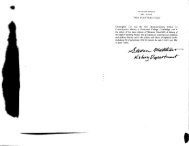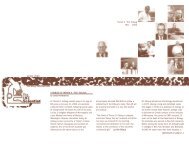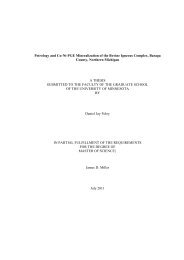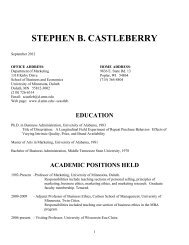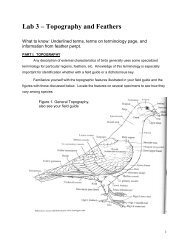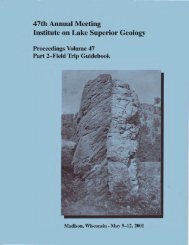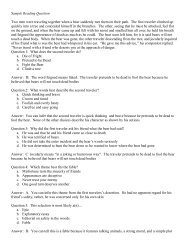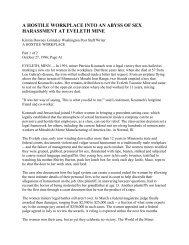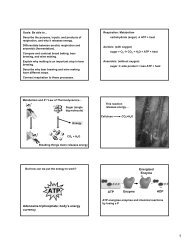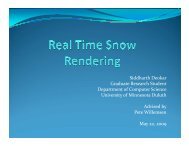Program, Abstracts, and Guidebooks - University of Minnesota Duluth
Program, Abstracts, and Guidebooks - University of Minnesota Duluth
Program, Abstracts, and Guidebooks - University of Minnesota Duluth
Create successful ePaper yourself
Turn your PDF publications into a flip-book with our unique Google optimized e-Paper software.
STOP 10<br />
ROVE FORMATION<br />
Rove shale is black, carbonaceous, <strong>and</strong> forms part <strong>of</strong><br />
the lower argillite unit (Morey, 1967); it contains several<br />
large, irregular "mushroom" shaped concretions. The concre—<br />
tions are composed <strong>of</strong> calcite with pyrite—marcasite b<strong>and</strong>s <strong>and</strong><br />
anthraxolite, <strong>and</strong> appear to have formed diagenetically.<br />
Remnant shale bedding planes are evident in some concretions.<br />
Shale beds are warped around the top <strong>and</strong> bottom <strong>of</strong> some<br />
concretions. Concretions are found throughout the lower<br />
argillite, <strong>and</strong> more commonly, have a distinct ablate spheroid<br />
shape.<br />
Proceed southeast on Highway 587.<br />
4.1 A large area <strong>of</strong> outcrop extends along the north side <strong>of</strong> the<br />
C.N.R. railway tracks <strong>and</strong> Highway 587 where they parallel<br />
Pass Lake.<br />
STOP lla SIBLEY GROUP - +ROVE<br />
FORMATION<br />
At the western end <strong>of</strong> this outcrop, a s<strong>and</strong>stone quarry<br />
provides an excellent exposure <strong>of</strong> Sibley s<strong>and</strong>stone. In the<br />
railway cut at the western edge <strong>of</strong> the quarry, Rove shale<br />
is altered to a reddish colour. This alteration affected<br />
the Rove for several feet below its contact with the Sibley<br />
Group. Basal conglomerate is absent at this point but is<br />
exposed to the east behind the small railroad house along<br />
the siding opposite the Pass Lake station.<br />
Clasts in the basal po1ymictic conglomerate are composed<br />
<strong>of</strong> 93 per cent Gun! lint iron formation, 6 per cent quartz<br />
<strong>and</strong> 1 per cent granite. Boulders are <strong>of</strong> variable size <strong>and</strong><br />
angularity, <strong>and</strong> are cemented in a s<strong>and</strong>y matrix. The contact<br />
with overlying s<strong>and</strong>stone is sharp; only a few pebbles are<br />
found in the base <strong>of</strong> the overlying unit. The s<strong>and</strong>stone is<br />
moderately to poorly indurated, thick bedded at the bottom<br />
<strong>of</strong> the section, <strong>and</strong> composed <strong>of</strong> quartz, with minor chert <strong>and</strong><br />
feldspar, in a calcite matrix.<br />
STOP llb<br />
At the west end <strong>of</strong> Pass Lake, a quarry, which may be<br />
reached by a short road leading from Highway 587 just east<br />
<strong>of</strong> the entrance to Sibley Provincial Park, has an excellent<br />
exposure <strong>of</strong> the contact between Rove shale <strong>and</strong> Sibley s<strong>and</strong>stone.<br />
The contact is occupied by a thin porphyritic dia—<br />
base sheet. S<strong>and</strong>stone beds have a few poorly developed<br />
cross laminations <strong>and</strong> ripple marks. Very little basal<br />
conglomerate is present in this outcrop.<br />
Return to Highway 587 <strong>and</strong> follow it back to Highwar<br />
11—17.




